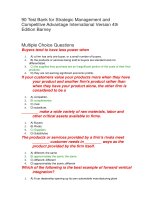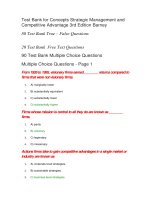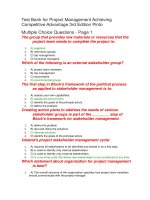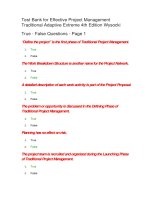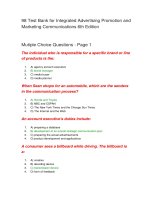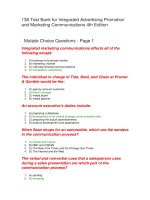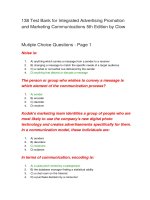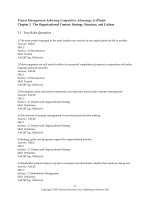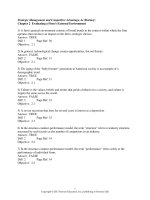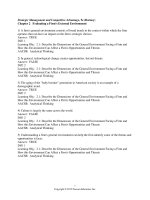190 test bank for concepts strategic management and competitive advantage 3rd edition barney
Bạn đang xem bản rút gọn của tài liệu. Xem và tải ngay bản đầy đủ của tài liệu tại đây (264.38 KB, 45 trang )
Test Bank for Concepts Strategic Management and
Competitive Advantage 3rd Edition Barney
80 Test Bank True – False Questions
20 Test Bank Free Text Questions
90 Test Bank Multiple Choice Questions
Multiple Choice Questions - Page 1
From 1926 to 1995, visionary firms earned ________ returns compared to
firms that were not visionary firms.
1.
A) marginally lower
2.
B) substantially equivalent
3.
C) substantially lower
4.
D) substantially higher
Firms whose mission is central to all they do are known as ________
firms.
1.
A) parity
2.
B) visionary
3.
C) legendary
4.
D) missionary
Actions firms take to gain competitive advantages in a single market or
industry are known as
1.
A) corporate level strategies.
2.
B) sustainable strategies.
3.
C) business level strategies.
4.
D) functional level strategies.
Actions firms take to gain competitive advantages by operating in multiple
markets or industries simultaneously are known as
1.
A) corporate level strategies.
2.
B) macro level strategies.
3.
C) business level strategies.
4.
D) functional strategies.
________ helps a firm understand which of its resources and capabilities
are likely to be sources of competitive advantage.
1.
A) Competitive analysis
2.
B) Internal analysis
3.
C) External analysis
4.
D) Comparative analysis
A firm's ________ is its long-term purpose that defines both what a firm
aspires to be in the long run and what it wants to avoid in the meantime.
1.
A) goal
2.
B) mission
3.
C) objective
4.
D) vision
The sequential set of analyses and choices that can increase the
likelihood that a firm will choose a strategy that generates competitive
advantages is the
1.
A) strategic management process.
2.
B) organizational change process.
3.
C) mission statement process.
4.
D) goal setting process.
A firm's ________ is a measure of its competitive advantage calculated
using information from a firm's published profit and loss and balance
sheet statements.
1.
A) sustainable performance
2.
B) strategic performance
3.
C) accounting performance
4.
D) economic performance
When a firm is able to create more economic value than rival firms it is
said to have a(n)
1.
A) strategic choice.
2.
B) comparative advantage.
3.
C) competitive advantage.
4.
D) economic advantage.
By conducting a(n) ________, a firm identifies the critical threats and
opportunities in its competitive environment.
1.
A) competitive analysis
2.
B) economic analysis
3.
C) external analysis
4.
D) internal analysis
_______ occurs when a firm adopts organizational policies and practices
that are consistent with its strategy.
1.
A) Strategy formulation
2.
B) Strategic control
3.
C) Strategy implementation
4.
D) Organizational change
________ are specific measurable targets a firm can use to evaluate the
extent to which it is realizing its mission.
1.
A) Objectives
2.
B) Visions
3.
C) Competitive Advantages
4.
D) Missions
Using ratio analysis, a firm earns ________ when its performance is
greater than the industry average.
1.
A) above average accounting performance
2.
B) below average economic performance
3.
C) above average economic performance
4.
D) below average accounting performance
Ratios that focus on the level of a firm's financial flexibility, including its
ability to obtain more debt, are known as
1.
A) activity ratios.
2.
B) leverage ratios.
3.
C) liquidity ratios.
4.
D) profitability ratios.
Firms that generate less economic value than their rivals experience a
competitive
1.
A) disadvantage.
2.
B) advantage.
3.
C) parity.
4.
D) preference.
In many ways, the difference between traditional economics research and
strategic management research is that the former attempts to explain why
________, while the latter attempts to explain ________
1.
A) competitive parity should not persist; why they should.
2.
B) competitive advantages should persist; when they can.
3.
C) competitive advantages should persist; why they should not.
4.
D) competitive advantages should not persist; when they can.
High quality objectives are those that are
1.
A) difficult to track over time.
2.
B) tightly connected to elements of a firm's mission.
3.
C) not quantitative.
4.
D)difficult to measure.
The mission statements of visionary firms
1.
2.
A) suggest that profit maximizing is an important corporate objective and is their
primary reason of existence.
B) suggest that profit maximizing is their primary reason for existence.
3.
C) suggest that profit maximizing, while an important corporate objective, is not
their primary reason for existence.
4.
D) suggest that profit maximizing is neither an important corporate objective nor
their primary reason for existence.
The difference between the perceived benefits gained by a customer that
purchases a firm's products or services and the full economic costs of
these products or services is known as
1.
A) comparative value.
2.
B) accounting value.
3.
C) economic value.
4.
D) sustainable value.
Missions are often written down in the form of
1.
A) corporate objectives.
2.
B) mission statements.
3.
C) organizational goals.
4.
D) vision statements.
A competitive advantage that lasts a very short period of time is known as
a ________ competitive advantage.
1.
A) transient
2.
B) sustained
3.
C) temporary
4.
D) perpetual
A firm's ________ is defined as its theory about how to gain competitive
advantages.
1.
A) mission
2.
B) strategy
3.
C) objectives
4.
D) vision
The ________ is the rate of return that a firm promises to pay its suppliers
of capital to induce them to invest in the firm.
1.
A) cost of debt
2.
B) cost of parity
3.
C) cost of capital
4.
D) cost of advantage
The percentage of a firm's total capital that is debt times the cost of debt
plus the percentage of a firm's total capital that is equity times the cost of
equity is the
1.
A) weighted average cost of capital.
2.
B) unweighted average cost of capital.
3.
C) weighted cost of capital.
4.
D) average cost of capital.
Which of the following statements regarding firm mission is accurate?
1.
A) While some firms have used their missions to develop strategies that create
significant competitive advantages, firm missions can hurt a firm's performance as
well.
2.
B) It is very rare for firms to be able to use their missions to develop strategies that
create significant competitive advantages, and most firm missions actually hurt their
performance.
3.
C) Virtually all firms have used missions to develop strategies that create
significant competitive advantages, while very few firms have used missions that
can hurt their performance.
4.
D) Missions tend to have very little impact on a firm's ability to create significant
competitive advantages.
________ measures of competitive advantage compare a firm's level of
return to its cost of capital instead of to the average level of return in the
industry.
1.
A) Sustainable
2.
B) Strategic
3.
C) Accounting
4.
D) Economic
_______ are ratios with some measure of profit in the numerator and some
measure of firms' size or assets in the denominator.
1.
A) Profitability ratios
2.
B) Liquidity ratios
3.
C) Activity ratios
4.
D) Leverage ratios
If TechnoGeek and VarsityBlue compete in the same market for the same
customer and TechnoGeek generates $900 of economic value each time it
sells a product or service while VarsityBlue generates $400 of economic
value each time it sells a product or service, TechnoGeek has a
competitive advantage of
1.
A) $360,000.
2.
B) $3,600.
3.
C) $500.
4.
D) $1,300.
Firms that create the same economic value as their rivals experience
competitive
1.
A) superiority.
2.
B) parity.
3.
C) advantage.
4.
D) disadvantage.
The two types of measures of competitive advantage include
1.
A) accounting measures and strategic measures.
2.
B) qualitative measures and quantitative measures.
3.
C) accounting measures and economic measures.
4.
D) strategic measures and economic measures.
90 Free Test Bank for Concepts Strategic
Management and Competitive Advantage 3rd Edition
Barney Multiple Choice Questions - Page 2
If the risk free rate of return is 4%, the market rate of return is 9%, and a
firm's beta is 2.0, what is the firm's cost of equity?
1.
A) 6
2.
B) 14
3.
C) 18
4.
D) 30
Theories of how to gain competitive advantage in an industry that emerge
over time or that have been radically reshaped once they are initially
implemented are known as
1.
A) ad hoc strategies.
2.
B) objective strategies.
3.
C) emergent strategies.
4.
D) planned strategies.
A firm that earns its cost of capital is said to be earning
1.
A) above normal economic performance.
2.
B) normal accounting performance.
3.
C) below normal economic performance.
4.
D) normal economic performance.
The values, beliefs and norms that guide behavior in society are known as
1.
A) culture.
2.
B) economics.
3.
C) climate.
4.
D) demographics.
When activity in an economy is relatively low for a short period of time,
the economy is said to be in a
1.
A) depression.
2.
B) boom.
3.
C) prosperous cycle.
4.
D) recession.
If a firm has total assets of $10 million, stockholder's equity of $6 million,
a cost of equity of 10, and an after tax cost of debt of 5%, what is the firm's
Weighted Average Cost of Capital?
1.
A) 7
2.
B) 8
3.
C) 1
4.
D) 18
Green Frog is an environmentally friendly firm in the cosmetics industry. If
during the strategic planning process Green Frog tried to determine the
critical threats and opportunities in its competitive environment, it would
be performing a(n)
1.
A) internal analysis.
2.
B) external analysis.
3.
C) economic analysis.
4.
D) WACC analysis.
Within the five forces framework, the five most common threats facing
firms from their competitive environment include each of the following
except
1.
A) substitutes.
2.
B) buyers.
3.
C) complementors.
4.
D) suppliers.
Green Frog is an environmentally friendly firm in the cosmetics industry
that has decided to undertake a strategic planning project. They want to
ensure that they perform the process correctly and so intend to start the
process with the first step of the strategic planning process which is
1.
A) measuring performance.
2.
B) setting objectives.
3.
C) defining their business level strategy.
4.
D) crafting a mission statement.
In a perfectly competitive industry
1.
2.
A) there are relatively few firms operating in the industry.
B) the products and services sold by firms in the industry are very different from
each other.
3.
C) it is not very costly for firms to exit the industry.
4.
D) it is very costly for firms to enter the industry.
Civil wars, political coups, terrorism, wars between countries, famines,
and country or regional economic recessions are all examples of which
element of the general environment?
1.
A) Culture
2.
B) Specific international events
3.
C) Economics
4.
D) Demographics
Firms in industries characterized by ________ can expect to earn only
competitive parity.
1.
A) monopoly
2.
B) monopolistic competition
3.
C) oligopoly
4.
D) perfect competition
Which of the following is a reason why it is important for students to
study strategy and the strategic management process?
1.
A) While strategic choices are generally limited to very experienced senior
managers in large organizations, in smaller and entrepreneurial firms many
employees end up being involved in the strategic management process.
2.
B) It can be very important to a new hire's career success to understand the
strategies of the firm that hired them and their place in implementing these
strategies.
3.
C) Studying strategy and the strategic management process can give students
tools to evaluate the strategies of firms that may employ them.
4.
D) All of the above.
Thermacorp's 17.3% ROE is an example of a(n) ________ ratio.
1.
A) profitability
2.
B) liquidity
3.
C) leverage
4.
D) activity
Thermacorp's weighted average cost of capital is 11.35. If the average
WACC in the heating and cooling industry is 19, Thermacorp can be said
to be earning
1.
A) below normal economic performance.
2.
B) below normal accounting performance.
3.
C) above normal accounting performance.
4.
D) above normal economic performance.
The realized strategy of most firms tends to be
1.
A) a combination of both intended and emergent strategies.
2.
B) almost exclusively a reflection of their emergent strategy.
3.
C) almost exclusively a reflection of their intended strategy.
4.
D) reflective of neither the firms intended nor emergent strategy.
In the S-C-P model, ________ refers to the strategies that firms in an
industry implement.
1.
A) performance
2.
B) structure
3.
C) conduct
4.
D) strategy
Green Frog is an environmentally friendly firm in the cosmetics industry. If
Green Frog were considering expanding beyond the cosmetics industry
into pharmaceuticals in order to gain competitive advantages by operating
in multiple markets and industries, this would be an example of which
type of strategy?
1.
A) Business level strategy
2.
B) Functional level strategy
3.
C) Corporate level strategy
4.
D) Marketing strategy
Green Frog is an environmentally friendly firm in the cosmetics industry. If
Green Frog undertook an analysis to help it understand which of its
resources and capabilities are likely to be sources of competitive
advantage and which are less likely to sources of such advantages they
would be performing a(n)
1.
A) economic analysis.
2.
B) internal analysis.
3.
C) WACC analysis.
4.
D) external analysis.
Thermacorp's cost of equity is 13.6. If the after tax cost of debt is 4.6, what
is the weighted average cost of capital?
1.
A) 11.35
2.
B) 15.85
3.
C) 11.2
4.
D) 13.2
All of the following are elements of the general environment except
1.
A) technological trends.
2.
B) industrial trends.
3.
C) demographic trends.
4.
D) cultural trends.
One of the first scholars to examine the longevity of competitive
advantage was
1.
A) Peter Roberts.
2.
B) Rich Houston.
3.
C) Geoffrey Waring.
4.
D) Dennis Mueller.
________ is/are the distribution of individuals in a society in terms of age,
sex, marital status, income, ethnicity, and other personal attributes that
may determine buying patterns.
1.
A) Technological trends
2.
B) Demographics
3.
C) Culture
4.
D) Economics
Which type of ratios focus on the ability of a firm to meet its short-term
financial obligations?
1.
A) leverage ratios
2.
B) activity ratios
3.
C) profitability ratios
4.
D) liquidity ratios
_____ strategies are theories of how to gain competitive advantage in an
industry that emerge over time or that have been radically reshaped once
they are initially implemented.
1.
A) Intended
2.
B) Realized
3.
C) Visionary.
4.
D) Emergent.
Green Frog is an environmentally friendly firm in the cosmetics industry.
Even though Green Frog is environmentally friendly, the strategic
planning team had decided that financial performance is one of the
company's top priorities. Which of the following is the best example of an
objective the company might use to help them achieve their goal of
superior financial performance?
1.
2.
A) Increasing profitability.
B) Growth in earnings per share averaging 15% or better annually for the next five
years.
3.
C) Improving product quality every quarter.
4.
D) Growing market share annually.
The view that equity holders only receive payment on their investment in a
firm after all legitimate claims by a firm's other stakeholders are satisfied
is known as the ________ view of equity holders.
1.
A) legitimate claimants
2.
B) residual claimants
3.
C) extraordinary claims
4.
D) stakeholder
The ________ consists of broad trends in the context in which a firm
operates that can have an impact on a firm's strategic choices.
1.
A) task environment
2.
B) micro-environment
3.
C) general environment
4.
D) internal environment
Thermacorp is in the heating and cooling industry and has total assets of
$20 million, with stockholders' equity of $15 million, an ROE of 17.3%, and
a firm Beta of 1.6. If the risk free rate of return is 4 and the market rate of
return is 10, what is the cost of equity?
1.
A) 19.6
2.
B) 25.28
3.
C) 13.6
4.
D) 7.75
If the average ROE in the heating and cooling industry is 10.1%, and
Thermacorp's ROE is 17.3%, Thermacorp is said to have
1.
A) below average economic performance.
2.
B) above average economic performance.
3.
C) below average accounting performance.
4.
D) above average accounting performance.
90 Free Test Bank for Concepts Strategic
Management and Competitive Advantage 3rd Edition
Barney Multiple Choice Questions - Page 3
________ exist when a firm's cost rise as a function of that firm's volume
of production.
1.
A) Diseconomies of scale
2.
B) Learning cure effects
3.
C) Economies of scale
4.
D) Economies of scope
Which of the following is the best example of forward vertical integration?
1.
2.
A) A car company opening its own chain of video rental stores.
B) A car company opening its own dealerships to sell its products directly to
customers.
3.
C) A car company opening a plant to product motorcycles.
4.
D) A car dealership opening up its own automobile manufacturing plant.
Which type of competition is characterized by a small number of firms,
homogeneous products and costly entry and exit?
1.
A) Monopoly
2.
B) Oligopoly
3.
C) Monopolistic competition
4.
D) Perfect competition
The advantages that come to firms that make important strategic and
technological decisions early in the development of an industry are known
as ________ advantages.
1.
A) first-comer
2.
B) early-entrant
3.
C) first-mover
4.
D) competitive
Frequent price cutting by firms in an industry, frequent introduction of
new products by firms in an industry and intense advertising campaigns
are indications of
1.
A) high threat of entry.
2.
B) high power of buyers.
3.
C) high threat of substitutes.
4.
D) high levels of rivalry.
If your customers value your products more when they have your product
and another firm's product rather than when they have your product
alone, the other firm is considered to be a
1.
A) rival.
2.
B) substitute.
3.
C) competitor.
4.
D) complementor.
Firms that engage in a long, systematic phased withdrawal from an
industry, extracting as much value as possible during the withdrawal
period are following a(n) ________ strategy.
1.
A) niche
2.
B) expansion
3.
C) harvest
4.
D) divestment
Which if the following attributes makes suppliers a stronger threat?
1.
A) The supplier's industry is dominated by a small number of firms.
2.
B) When supplies are not able to enter into and begin competing in a firm's
industry.
3.
C) When suppliers are threatened by substitutes.
4.
D) When the product or service provided by suppliers is not highly differentiated.
Mature industries are characterized by
1.
A) a decrease in the amount of international competition.
2.
B) an increase in total industry demand.
3.
C) a slowdown in the introduction of new products or services.
4.
D) faster increases in production capacity.
In general, first-mover advantages can arise from any of these sources
except
1.
A) preemption of strategically valuable assets.
2.
B) technological leadership.
3.
4.
C) using an imitative strategy to introduce improved versions of competitors new
products.
D) the creation of customer switching costs.
________ make a wide variety of raw materials, labor and other critical
assets available to firms.
1.
A) Rivals
2.
B) Suppliers
3.
C) Buyers
4.
D) Substitutes
The most promising opportunity for a firm in a declining industry is to
1.
A) establish itself as a first mover in the post-shakeout industry.
2.
B) become a fast follower in the pre-shakeout industry.
3.
C) merge with another firm.
4.
D) become a market leader in the pre-shakeout industry.
Which of the following statements regarding substitutes is accurate?
1.
A) In the extreme, substitutes can ultimately replace an industry's products or
services.
2.
B) The importance of substitutes in reducing the profit potential in a wide variety of
industries is decreasing.
3.
C) Substitutes place a floor on the prices firms in an industry can charge and on
the profits firms in an industry can earn.
4.
D) Substitutes rarely impact the profitability that firm firms in an industry can earn.
Buyers tend to have less power when
1.
A) the products or services being sold to buyers are standard and not
differentiated.
2.
B) a firm has only one buyer, or a small number of buyers.
3.
C) they are not earning significant economic profits.
4.
D) the supplies they purchase are an insignificant portion of the costs of their final
products.
Overall, the average level of performance in an industry is likely to be
highest when
1.
A) the threat level of rivalry, substitutes and new entrants is high, but the threat
level of buyers and supplies is low.
2.
B) the threat level of all five forces is low.
3.
C) the threat level of all five forces is high.
4.
D) the threat level of rivalry, and substitutes is low, but the threat level of suppliers,
buyers and new entrants is high.
A(n) ________ is any individual, group, or organization outside a firm that
seeks to reduce the level of that firm's performance.
1.
A) competitive advantage
2.
B) environmental opportunity
3.
C) environmental equalizer
4.
D) environmental threat
The products or services provided by a firm's rivals meet ________
customer needs in ________ ways as the product provided by the firm
itself.
1.
A) approximately the same; different
2.
B) approximately the same; the same
3.
C) different; different
4.
D) different; the same
The major opportunity facing firms in fragmented industries is
1.
2.
A) refining their current products and emphasizing an increase in service quality.
B) the implementation of strategies that began to consolidate the industry into a
smaller number of firms.
3.
C) developing new products and technologies.
4.
D) creating a first mover advantage through technological leadership.
The products or services provided by a firm's substitutes meet ________
customer needs in ________ ways as the product provided by the firm
itself.
1.
A) different; different
2.
B) different; the same
3.
C) approximately the same; the same
4.
D) approximately the same; different
Industries in which a large number of small or medium-sized firms operate
and no small set of firms has dominant market share or creates dominant
technologies are called ________ industries.
1.
A) declining
2.
B) emerging
3.
C) fragmented
4.
D) mature
Rivalry tends to be high when
1.
A) when production capacity can be added in small increments.
2.
B) there are few firms in an industry and these firms tend to be unequal in size.
3.
C) firms are unable to differentiate their products.
4.
D) the industry growth rate is higher.
Firms that have either recently begun operations in an industry or that
threaten to being operations in an industry soon are considered to be
________ in the five forces framework.
1.
A) barriers to entry
2.
B) buyers
3.
C) new entrants
4.
D) suppliers
________ are advantages that come to firms that make important strategic
and technological decisions early in the development of an industry.
1.
A) First-mover advantages
2.
B) Visionary advantages
3.
C) Comparative advantages
4.
D) Missionary advantages
All other things being equal, under which of the following would lead to
lower barriers to entry in an industry?
1.
A) Products are highly differentiated in the industry.
2.
B) The existence of economies of scale in the industry.
3.
C) Raw materials are widely and readily available at a competitive price.
4.
D) Industry incumbents have learning-curve cost advantages.
Consolidation strategy is a good option in what type of industry?.
1.
A) Emerging
2.
B) Mature
3.
C) Declining
4.
D) Fragmented
Which type of competition is characterized by a large number of firms,
heterogeneous products and low cost of entry and exit?
1.
A) Oligopoly
2.
B) Monopoly
3.
C) Perfect competition
4.
D) Monopolistic competition
_______ costs exist when customers make investments in order to use a
firm's particular products or services.
1.
A) Competitive-switching
2.
B) Strategic-switching
3.
C) Customer-switching
4.
D) Resource-switching
________ valuable assets are resources required to successfully compete
in an industry.
1.
A) Strategically
2.
B) Domestically
3.
C) Pedestrian
4.
D) Globally
________ industries are newly created, or newly recreated industries
formed by technological innovations, changes in demand, or the
emergence of new customer needs.
1.
A) Mature
2.
B) Fragmented
3.
C) Declining
4.
D) Emerging
An industry in which a large number of small or medium-sized firms
operate and no small set of firms has dominant market share or creates
dominant technologies is known as a(n) ________ industry.
1.
A) fragmented
2.
B) mature
3.
C) consolidated
4.
D) emerging
80 Free Test Bank for Concepts Strategic
Management and Competitive Advantage 3rd Edition
Barney True - False Questions - Page 1
Emergent strategies are only important when a firm fails to implement the
strategic management process effectively.
1.
True
2.
False
A firm's mission defines both what it wants to be in the long run and what
it wants to avoid in the meantime.
1.
True
2.
False
Firms that create the same economic value as their rivals experience
competitive parity.
1.
True
2.
False
Objectives are the specific measurable targets a firm can use to evaluate
the extent to which it is realizing its mission.
1.
True
2.
False
The size of a firm's competitive advantage is the sum of the economic
value a firm is able to create and the economic value rivals are able to
create.
1.
True
2.
False
The second step in the strategic management process is the definition of
a firm's mission.
1.
True
2.
False
The residual claimants' view of equity holders argues that the interests of
equity holders and a firm's other stakeholders often collide.
1.
True
2.
False
When a firm earns above average accounting performance, it is said to
enjoy competitive parity.
1.
True
2.
False
